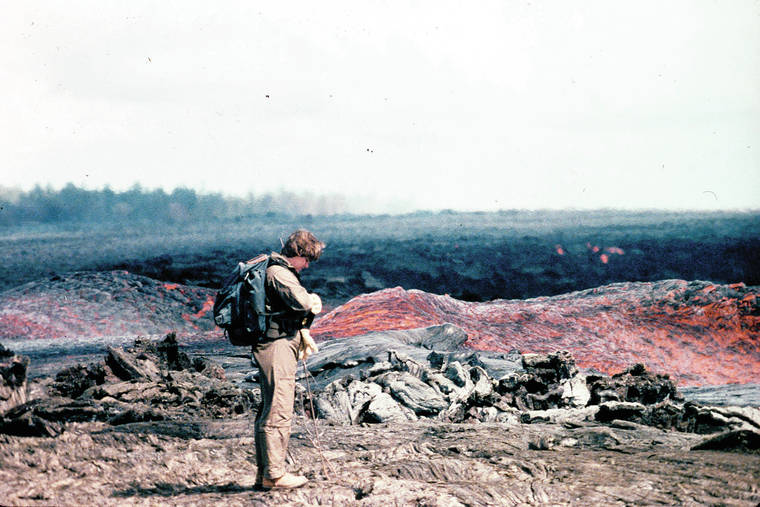Volcano Watch: Extraordinary tenure ends for leader of USGS Hawaiian Volcano Observatory

Tina Neal, HVO Scientist-in-Charge from 2015–20, ended her tenure on June 19. (USGS photo)

Tina Neal responding to Kilauea’s Pu‘u ‘O‘o eruption in November of 1983. At that time, USGS personal protective equipment standards differed. (USGS photo)
The extraordinary leadership of Tina Neal as Scientist-in-Charge of the USGS Hawaiian Volcano Observatory comes to an end this week, when she returns to the Alaska Volcano Observatory after fulfilling her five-year commitment to HVO. David Phillips, HVO’s Deputy SIC, will take the helm until Tina’s successor arrives.
The extraordinary leadership of Tina Neal as Scientist-in-Charge of the USGS Hawaiian Volcano Observatory comes to an end this week, when she returns to the Alaska Volcano Observatory after fulfilling her five-year commitment to HVO. David Phillips, HVO’s Deputy SIC, will take the helm until Tina’s successor arrives.
By her own admission, nimbleness became a central theme of Tina’s leadership. She continually strived to move HVO forward as a responsive and innovative team during periods of rapid and remarkable changes on Kilauea Volcano, within the observatory, and around the world.
ADVERTISING
Tina began her HVO leadership role in March 2015 just as Kilauea’s “June 27th” lava-flow threat to Pahoa ended. In May 2016, a new vent erupted on the flank of Pu‘u ‘O‘o, and by late July, the resulting lava flow entered the ocean at Kamokuna in Hawaii Volcanoes National Park. The lava entry quickly drew thousands of visitors on land and in boats to witness up close lava building new land.
Tina spurred HVO geologists to take a fresh and detailed look at hazards associated with the growth and collapse of active lava deltas as described in science publications and internal reports. Their analyses resulted in the designation of a high-hazard area extending a minimum distance of 300 m (984 ft) around the lava-entry zone. The National Park used this revised distance to establish a safe viewing area, which ultimately helped Park personnel to avert injuries or loss of life during a large lava delta collapse on New Year’s Eve in 2016.
On April 30, 2018, a large intrusion of magma into the lower East Rift Zone of Kilauea began, prompting HVO to issue a Volcano Activity Notice describing the activity and indicating that an eruption was possible downrift (east) of Pu‘u ‘O‘o. On May 3, the first of many fissures erupted downrift of Pu‘u ‘O‘o in the Leilani Estates subdivision and nearby areas. Soon after, Kilauea’s summit began collapsing as magma from the summit reservoir steadily moved into the lower East Rift Zone.
Tina was at the center of HVO’s response to this remarkable eruption and summit collapse. Earthquakes and ground settling at the summit soon damaged HVO’s main building, which forced the immediate and unprecedented move of the observatory’s center of operations from Hawaii Volcanoes National Park to temporary offices in Hilo, the first of three moves in less than a year.
During the 2018 events, HVO sustained 24/7 operations with support from nearly 100 scientists and volunteers chiefly from the USGS and University of Hawaii. Tina was constantly on the move to bolster HVO’s response in order to provide up-to-date scientific information and warnings for the public, as well as Federal, State, and County incident command teams, and to research and document the eruption for real-time and future analyses of extensive data sets.
After the eruption ceased, Tina began the long process of planning for a new USGS office building and field station, which will house both HVO and the Pacific Islands Ecosystem Research Center. Numerous meetings regarding location, type of facilities, construction requirements and costs have resulted in preliminary plans that will guide the process forward.
During her tenure, Tina persistently worked to embrace expanded volcano-monitoring capabilities, including the use of Unoccupied Aircraft Systems; anticipate changing hazardous conditions on Kilauea; prepare HVO staff and Hawaii residents and officials for a future eruption of Mauna Loa; and ensure employee safety and well-being. She also supported the dissemination of authoritative USGS information through news and social media, public briefings, and written reports and publications.
Tina’s most lasting legacy, however, will undoubtedly be the unprecedented numbers of new HVO staff hired to fill permanent USGS positions added to improve the observatory’s science and operational capabilities and to replace retirements and transfers. She also oversaw the addition of several temporary positions through a long-standing cooperative agreement with the University of Hawaii at Hilo.
In a final challenge, Tina ends her leadership role amidst the COVID-19 pandemic, which has forced HVO staff to work remotely and embrace innovative ways of interacting. All the while, she kept employees safe, engaged, and ready to face future changes on Hawaiian volcanoes.
We offer Tina a profound “mahalo” for her leadership, compassion, inspiration, and nimbleness over the past five years and wish her well in her future endeavors in Alaska.
Volcano activity updates
Kilauea Volcano is not erupting. Its USGS Volcano Alert level remains at NORMAL (https://volcanoes.usgs.gov/vhp/about_alerts.html). Kilauea updates are issued monthly.
Kilauea monitoring data for the past month show variable but typical rates of seismicity and ground deformation, low rates of sulfur dioxide emissions, and only minor geologic changes since the end of eruptive activity in September 2018. The water lake at the bottom of Halema‘uma‘u continues to slowly expand and deepen. For the most current information on the lake, see https://volcanoes.usgs.gov/volcanoes/Kilauea/summit_water_resources.html
Mauna Loa is not erupting and remains at Volcano Alert Level ADVISORY. This alert level does not mean that an eruption is imminent or that progression to eruption from current level of unrest is certain. Mauna Loa updates are issued weekly.
This past week, about 75 small-magnitude earthquakes were recorded beneath the upper-elevations of Mauna Loa; most of these occurred at shallow depths of less than 8 kilometers (~5 miles). Global Positioning System measurements show long-term slowly increasing summit inflation, consistent with magma supply to the volcano’s shallow storage system. Gas concentrations and fumarole temperatures as measured at both Sulphur Cone and the summit remain stable. Webcams show no changes to the landscape. For more information on current monitoring of Mauna Loa Volcano, see: https://volcanoes.usgs.gov/volcanoes/mauna_loa/monitoring_summary.html.
No felt earthquakes were reported in the Hawaiian islands during the past week.
HVO continues to closely monitor both Kilauea and Mauna Loa for any signs of increased activity.
Please visit HVO’s website for past Volcano Watch articles,for past Volcano Watch articles, Kilauea and Mauna Loa updates, volcano photos, maps, recent earthquake info, and more. Email questions to askHVO@usgs.gov.
Volcano Watch is a weekly article and activity update written by U.S. Geological Survey Hawaiian Volcano Observatory scientists and affiliates.


